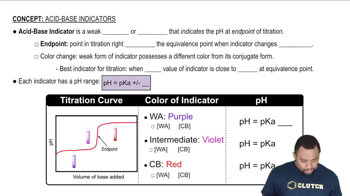Here are the essential concepts you must grasp in order to answer the question correctly.
pH Scale
The pH scale measures the acidity or basicity of a solution, ranging from 0 to 14. A pH of 0 to 6 indicates acidic conditions, while a pH of 7 is neutral, and 8 to 14 indicates basic conditions. Understanding the pH scale is crucial for selecting appropriate indicators that change color at specific pH levels.
Recommended video:
Acid-Base Indicators
Acid-base indicators are substances that change color in response to changes in pH. Each indicator has a specific pH range over which it changes color, making it suitable for detecting pH changes in that range. For example, phenol red changes from yellow in acidic conditions to red in neutral to basic conditions, while thymolphthalein transitions from colorless in acidic to blue in basic conditions.
Recommended video:
Choosing the Right Indicator
Selecting the appropriate indicator for a specific pH range is essential for accurate pH detection. In this case, to detect a pH change from 2 to 0, an indicator that operates effectively in the acidic range (0-6) is needed. Analyzing the color change ranges of the indicators provided will help determine which one is most suitable for this specific pH transition.
Recommended video:

 Verified step by step guidance
Verified step by step guidance


